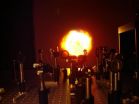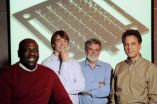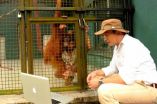(Press-News.org) The thickest layers of global smog — caused by traffic, industry, and natural minerals, among other factors — are found over the world's megacities. But getting an accurate measurement of pollution is no easy task. On-the-ground monitoring stations do not always provide the most accurate picture —monitoring stations depend heavily on local positioning and some cities put stations in urban centers, while others build on the edge of a city.
Now Prof. Pinhas Alpert of Tel Aviv University's Department of Geophysics and Planetary Sciences and head of the Porter School of Environmental Studies, with graduate student Olga Shvainshteinand and Dr. Pavel Kishcha, is turning to three of NASA's high-tech satellites for a comprehensive view of pollutants in the atmosphere. Using eight years' worth of data collected by the satellites, the researchers tracked pollution trends for 189 megacities — metropolitan hotspots where the population exceeds 2 million. 58 of these megacities, including New York City, Tokyo, and Mumbai, have populations that exceed 5 million.
Their method, published in the American Journal of Climate Change, is the first to provide standardized global testing of pollution levels. Beyond uncovering reliable data about pollution trends, Prof. Alpert believes that this monitoring method will also hold countries accountable for their emissions and encourage more environmentally friendly practices.
A "three judge" panel
The smog which often covers megacities is actually a thick atmospheric layer several hundred meters above the Earth's surface, comprised of particles of pollutants. It's an environmental hazard and a severe health risk for those living below, who breathe in the particulates.
To accurately analyse the level of pollution over each megacity, the researchers used data gathered by three aerosol-monitoring satellites, called MODIS-Terra, MODIS-Aqua, and MISR, which NASA launched from 2000 through 2002. The combined data these satellites provide constitute an accurate survey of aerosol concentrations a few hundred meters above Earth.
Prof. Alpert likens the use of three satellites to the traditional Jewish idea of the three-judge panel. "In the Jewish tradition, individual judges don't decide cases. There must be a minimum of three. You need a majority opinion," he says. "By merging the data from three imperfect sensors, their flaws are mostly counterbalanced. In cases where the three sensors show differing signs of pollution levels, more research is required."
Winners and losers
Northeast China, India, the Middle East, and Central Africa are currently leading in pollution increase, including Bangalore, India, with a 34 percent average increase in aerosol concentration between 2002 and 2010. Ibdan, Nigeria, was also part of that group. Europe and Northeast and Central North America are seeing the largest decreases in aerosol concentrations overall. Among the cleanest cities were Houston, with a 31 percent decrease over the time period; Curitiba, Brazil, with a 26 percent decrease; and Stockholm, Sweden, with a 23 percent decrease.
Some American cities were on the list of increased pollution levels, including Portland with a 53 percent average increase and Seattle with a 32 percent average increase, but Prof. Alpert believes these numbers reflect the multiple wildfires that have been happening in the region in the second half of the period examined. In the future, he hopes to develop a method for separating such natural causes of pollution from man-made pollutants for more accurate data.
An honest view of emissions
A standardized approach to smog analysis is made difficult by often unreliable data from monitoring stations, the reluctance of politicians or government ministries to offer accurate numbers on pollution, and even a complete lack of monitoring in major parts of the world, says Prof. Alpert. When it comes to international treaties aimed at reducing pollution, this measurement method could help to keep all countries accountable for their promises by tracking compliance in an equitable way. Cities that successfully decrease pollution could be applauded for their efforts and stand as a positive example to follow, he suggests.
###
American Friends of Tel Aviv University supports Israel's leading, most comprehensive and most sought-after center of higher learning. Independently ranked 94th among the world's top universities for the impact of its research, TAU's innovations and discoveries are cited more often by the global scientific community than all but 10 other universities.
Internationally recognized for the scope and groundbreaking nature of its research and scholarship, Tel Aviv University consistently produces work with profound implications for the future.
Tracking pollution from outer space
Tel Aviv University team uses NASA satellites to measure pollution hovering over world's megacities
2012-11-27
ELSE PRESS RELEASES FROM THIS DATE:
Illuminating the no-man's land of waters' surface
2012-11-27
Water repelling molecules are said to be hydrophobic. The hydration – or formation of water interfaces around hydrophobic molecules – is important for many biological processes: protein folding, membrane formation, transport of proteins across an interface, the transmission of action potentials across membranes. It is involved as well in the process of creating mayonnaise, or in the fact that you can get rid of fat with soap. Hydrophobic interfaces although long studied, are poorly understood.
Here's an amusing kitchen-table experiment to illustrate waters unusual properties: ...
Measles vaccine given with a microneedle patch could boost immunization programs
2012-11-27
Measles vaccine given with painless and easy-to-administer microneedle patches can immunize against measles at least as well as vaccine given with conventional hypodermic needles, according to research done by the Georgia Institute of Technology and the Centers for Disease Control and Prevention (CDC).
In the study, the researchers developed a technique to dry and stabilize the measles vaccine – which depends on a live attenuated virus – and showed that it remained effective for at least 30 days after being placed onto the microneedles. They also demonstrated that the ...
Safer spinach? Scientist's technique dramatically reduces E. coli numbers
2012-11-27
URBANA – University of Illinois scientists have found a way to boost current industry capabilities when it comes to reducing the number of E. coli 0157:H7 cells that may live undetected on spinach leaves.
"By combining continuous ultrasound treatment with chlorine washing, we can reduce the total number of foodborne pathogenic bacteria by over 99.99 percent," said Hao Feng, a U of I professor of food science and human nutrition.
According to Feng, the USDA is looking for proposed technologies that can achieve a 4 to 6 log reduction in pathogen cells (a 6 log reduction ...
'Walking on marbles' could be a thing of the past for arthritis patients
2012-11-27
Researchers at the University of Southampton are to undertake a new stage of a study aimed at improving the health and mobility of those suffering from the common complaint of 'walking on marbles' associated with Rheumatoid Arthritis (RA) in the feet.
RA is the second most common form of arthritis in the UK, affecting almost 600,000 people, which results in the destruction of joints around the body caused by inflammation.
Forefeet often contain some of the first joints to be affected and those with the condition often say that they feel like they are 'walking on marbles'. ...
Seeing the world through the eyes of an Orangutan
2012-11-27
She is a captive bred Sumatran orangutan. He is a neuroscientist specialising in cognitive and sensory systems research. With the help of specially adapted eye tracking equipment they are hoping to explain some of the mysteries of the visual brain and improve the lives of captive bred animals.
Dr Neil Mennie, from The University of Nottingham Malaysia Campus (UNMC), has received funding from Ministry of Science and Technology and Innovation, Malaysia (MOSTI) to study the eye movements of Tsunami — a seven year old orangutan at The National Zoo of Malaysia (Zoo Negara). ...
Gene linked to respiratory distress in babies
2012-11-27
Some infants are more susceptible to potentially life-threatening breathing problems after birth, and rare, inherited DNA differences may explain why, according to research at Washington University School of Medicine in St. Louis.
The study is the first to identify a single gene — ABCA3 — that is associated with a significant number of cases of respiratory distress syndrome (RDS) in babies born at or near full term. RDS is the most common respiratory problem in newborns and the most common lung-related cause of death and disease among U.S. infants less than a year old.
Their ...
The installed price of solar photovoltaic systems in the US continues to decline at a rapid pace
2012-11-27
Berkeley, CA — The installed price of solar photovoltaic (PV) power systems in the United States fell substantially in 2011 and through the first half of 2012, according to the latest edition of Tracking the Sun, an annual PV cost-tracking report produced by the Department of Energy's Lawrence Berkeley National Laboratory (Berkeley Lab).
The median installed price of residential and commercial PV systems completed in 2011 fell by roughly 11 to 14 percent from the year before, depending on system size, and, in California, prices fell by an additional 3 to 7 percent within ...
Topical simvastatin shown to accelerate wound healing in diabetes
2012-11-27
Philadelphia, PA, November 27, 2012 – Delayed wound healing is a major complication of diabetes because the physiological changes in tissues and cells impair the wound healing process. This can result in additional disease outcomes such as diabetic foot ulcer, a significant cause of morbidity in the growing population of diabetic patients. A new study has found that topically applied simvastatin accelerates wound healing in diabetic mice, suggesting important implications for humans with diabetes. This study is published in the December issue of The American Journal of ...
Amyloid imaging helps in evaluating possible Alzheimer disease
2012-11-27
Philadelphia, Pa. (November 27, 2012) – A test to detect brain amyloid deposits associated with Alzheimer disease (AD) provides doctors with useful information on treatment and further testing for patients with cognitive impairment, according to a study published online by the journal Alzheimer Disease & Associated Disorders. The journal is published by Lippincott Williams & Wilkins, a part ofWolters Kluwer Health.
Positron emission tomography (PET) scans using a biomarker called florbetapir F18 can show amyloid plaques in the brain—a characteristic feature of AD. ...
What keeps a cell's energy source going
2012-11-27
PHILADELPHIA — Most healthy cells rely on a complicated process to produce the fuel ATP. Knowing how ATP is produced by the cell's energy storehouse – the mitochondria -- is important for understanding a cell's normal state, as well as what happens when things go wrong, for example in cancer, cardiovascular disease, neurodegeneration, and many rare disorders of the mitochondria.
Two years ago, Kevin Foskett, PhD, professor of Physiology at the Perelman School of Medicine, University of Pennsylvania, and colleagues discovered that fundamental control of ATP production ...
LAST 30 PRESS RELEASES:
Making lighter work of calculating fluid and heat flow
Normalizing blood sugar can halve heart attack risk
Lowering blood sugar cuts heart attack risk in people with prediabetes
Study links genetic variants to risk of blinding eye disease in premature infants
Non-opioid ‘pain sponge’ therapy halts cartilage degeneration and relieves chronic pain
AI can pick up cultural values by mimicking how kids learn
China’s ecological redlines offer fast track to 30 x 30 global conservation goal
Invisible indoor threats: emerging household contaminants and their growing risks to human health
Adding antibody treatment to chemo boosts outcomes for children with rare cancer
Germline pathogenic variants among women without a history of breast cancer
Tanning beds triple melanoma risk, potentially causing broad DNA damage
Unique bond identified as key to viral infection speed
Indoor tanning makes youthful skin much older on a genetic level
Mouse model sheds new light on the causes and potential solutions to human GI problems linked to muscular dystrophy
The Journal of Nuclear Medicine ahead-of-print tip sheet: December 12, 2025
Smarter tools for peering into the microscopic world
Applications open for funding to conduct research in the Kinsey Institute archives
Global measure underestimates the severity of food insecurity
Child survivors of critical illness are missing out on timely follow up care
Risk-based vs annual breast cancer screening / the WISDOM randomized clinical trial
University of Toronto launches Electric Vehicle Innovation Ontario to accelerate advanced EV technologies and build Canada’s innovation advantage
Early relapse predicts poor outcomes in aggressive blood cancer
American College of Lifestyle Medicine applauds two CMS models aligned with lifestyle medicine practice and reimbursement
Clinical trial finds cannabis use not a barrier to quitting nicotine vaping
Supplemental nutrition assistance program policies and food insecurity
Switching immune cells to “night mode” could limit damage after a heart attack, study suggests
URI-based Global RIghts Project report spotlights continued troubling trends in worldwide inhumane treatment
Neutrophils are less aggressive at night, explaining why nighttime heart attacks cause less damage than daytime events
Menopausal hormone therapy may not pose breast cancer risk for women with BRCA mutations
Mobile health tool may improve quality of life for adolescent and young adult breast cancer survivors
[Press-News.org] Tracking pollution from outer spaceTel Aviv University team uses NASA satellites to measure pollution hovering over world's megacities



